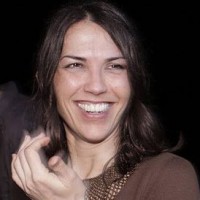I woke on the eve of the Spring Equinox wanting a riot of light, and crocuses and daffodils like I am ‘supposed’ to get—instead, I received a world blanketed with a solemn and secretive snow.
I wanted a straight line, a fingerpost pointing the way to ‘Spring!’ I got a sigh of resignation of another New England Spring called on account of snow—my altar decorations look like a pathetic little curl of hope against the white snow sky rearing up in my window.
If you know Ostara, the pagan celebration of the Spring Equinox, it looks like the secular imagery of Easter. It is the time of baby animals being born, of planting seeds. It’s fun, light, about babyhood and childhood, the ebullient laughter of the year, innocent and pure. Of course there are (as always) older, deeper mysteries running, too.
So I wanted it easy; I wanted the top note of the holiday: rabbits, cute and fuzzy. Instead, I got the bottom note: hares, intimidating and weird.
We start learning about these holidays by their top notes: rabbits, eggs, bunnies and babies. But learning the ancientness of them, the part that demands we show up as adults in our full humanity, is like discovering the older versions of fairy tales full of uncanniness.
The ancient-er aspect of the holiday is about hares. About their shapeshifting abilities, about their tricksterism, about eggs which they may or may not have lain. Rabbits can be comprehended (at least we think they can), but hares present something else again to our dreamtime consciousness.
With their great, golden, staring eyes, they can be otherworldly, challenging, intimidating. They can appear mad—we sense that they are as much about death as they are about life. They are another octave of the holiday of Ostara.
We graduate in our way from rabbits to hares, from assuming that progress toward goals should move in a straight line, that questions all have answers, to knowing that it seldom actually does that, and that sometimes they don’t.
The arrival of Spring does not come in a straight line—it frustrates your expectations with cold nights, cancelled Easter-egg hunts, and anachronistic snows. Like a hare who can leap straight up into the air out of her nest and with a twist of her hindquarters, land ten feet away in order not to leave a scent, Spring aims to vex and a-maze anyone on its tail.
It is wayward and defiant—it arrives exactly when it means to.
It’s rare for people to address the tension of this holiday; I’ve only had one teacher who ever did. But there can be a tension to the Spring Equinox, taut enough to balance an egg on its end. It’s the tension between what you expect and what is.
The holidays that spoke the Wheel of the Year serve as markers, and markers can be disheartening if we feel like we are not where we are supposed to be in the year at this time, or in our life on such-and-such a birth-day. We can get discouraged—but we don’t need to.
I tend to write about the hare-side of holidays, because that is the time we need to have faith to see that we actually are on course, that things arrive in their own grace and good time, that there really actually are crocuses under the snow.
So, I give you as an Ostara gift a hare image…and a mystery.
Over and again, you will find as a motif in medieval construction throughout England and the European continent three hares running in a circle, joined by the touching tips of their ears. If you look carefully, you will see that each hare has two ears but among them they have only three. This symbol-puzzle occurs and recurs in the roof-bosses of old houses, and in the timbered arches of churches. It is called ‘Tinner’s Hares’ because the tinsmiths of Dartmoor adopted it as a symbol, but it is older than they; it occurs across continents, in Judaic art, in Islamic art, in Russia, in Iran, in Buddhist art, in caves in China, arising through convergent evolution or communicated along the Silk Road.
Three in One Field, by Celia Hart.Three hares, three ears, three emanations, wheeling. Nobody knows exactly what they mean.
They are not the Trinity, for they predate Christianity.
The seed of the future is in the present—the seed of the present is in the past. The future to come, will become another past.
We are held in this pinwheel of time, balanced among times, constantly becoming.
You are being moved.
Hold on to the ears of the Year and ride it with trust; let go of expectation and fall in love with reality.
Remember that Hare twists and turns and then all of a sudden she leaps…and at last it is Spring.
All the blessings I could write in words can only begin to describe how much you deserve to be blessed.
Take all of the Spring into you, for all that it Is.
Blessed be, and Love!
Laura
PS: If you want to receive a little more seasonal education about hares and their ways, here is a tutorial video by the magical Laura Daligan:
Like elephant journal on Facebook.
Ed: Bryonie Wise
(Photography by Jeff Frazier, at Boo Rochman Memorial Park, Carbondale, Illinois: www.jefffrazier.com )


 Share on bsky
Share on bsky




Read 10 comments and reply